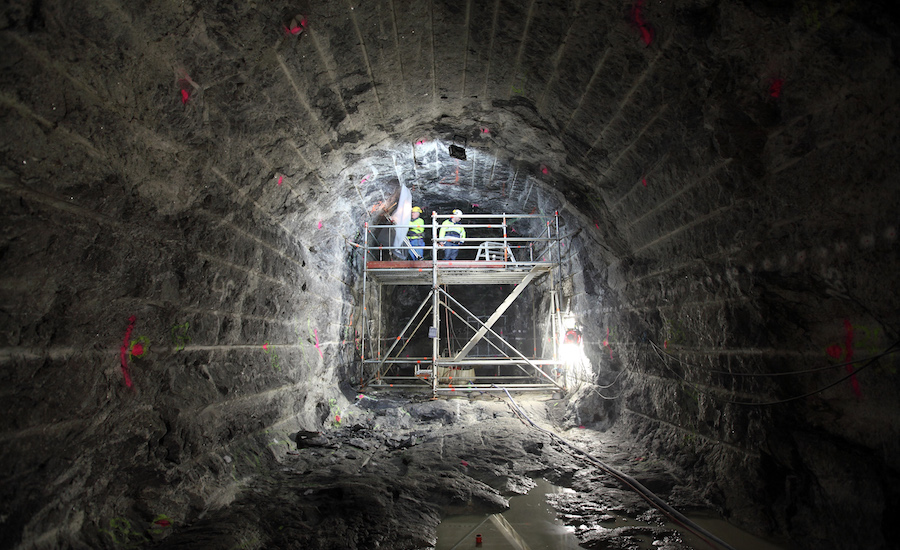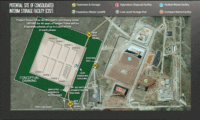The world’s nuclear power plants generate 12,000 tonnes of high-level waste and spent fuel each year. In countries with open fuel cycles, in which fuel is not reprocessed, the spent fuel is cooled for about 20 years in pools of water and then stored in dry casks on plant property to await completion of appropriate permanent repository facilities.
Repositories for disposal of low-level and intermediate radioactive wastes are operating in a number of countries, but high-level wastes require more secure disposal.
“Today, there is strong international consensus that a deep-mined, geologic repository used to dispose of high-activity, long-lived radioactive waste ‘provides a unique level and duration of protection,’” according to a February report by the U.S. Nuclear Waste Technical Review Board (NWTRB) that quotes a Nuclear Energy Agency study.
However, the review board adds, “the route and pace in moving toward deep underground disposition of high-activity, long-lived radioactive waste vary considerably among countries with nuclear programs.”
Repository development is most advanced in Finland, Sweden and France, but none will be operational until 2021. Operational dates for most are expected much later in the century.
Finland
With only four nuclear plants totaling 2,700 MW of capacity and one 1,700-MW plant under construction, Finland has one of the world’s smaller nuclear fleets, but its permanent spent-nuclear-fuel repository is the nearest to construction.
Waste-management company Posiva Oy received a construction license in December 2015 for the Onkalo repository on Olkiluoto Island, located in Eurajoki, Finland, where two reactors are operating and a third is under construction. The product of 40 years of research and development by Posiva, the Onkalo project will consist of a plant to encapsulate spent fuel in canisters for permanent disposal 400 meters deep in granite. Repository operations are expected to start in the early 2020s, the NWTRB report says.
Sweden
Forsmark, the site of one of Sweden’s three active nuclear power plants, is also the final repository for short-lived radioactive waste. The Swedish Nuclear Fuel and Waste Management Co. (SKB), which operates that facility, has applied for permission to build a final spent-fuel repository in Forsmark and an encapsulation plant in Oskarshamn, another nuclear power-plant site, where spent fuel now is in interim storage.
When the repository is in operation, spent fuel encapsulated in sealed, 5-cm-thick copper canisters will descend a 5-km-long ramp to be entombed in about 60 km of tunnels nearly 500 m deep in granite. It will be packed in a buffer of bentonite clay in the deposition hole, and the granite bedrock will become the ultimate barrier to protect people and the environment from harmful radiation.
SKB hopes to begin construction in the early 2020s and to be operational within 10 years. Full development is expected to take about 60 years.
France
A high degree of commitment to nuclear energy for power generation, combined with participation by the public in decisions on waste disposal, may prove to be the key to relatively prompt completion of France’s Cigéo facility. With 58 reactors, France is second only to the United States in the number of operating units; its percentage of total national power generation with nuclear energy leads the world at 74.8%.
Acting on invitation by the local authorities, Andra, the national radioactive-waste-management agency, has completed an underground research laboratory at Bure in the Meuse district with shafts, drifts and ventilation necessary to study the feasibility of the site for a permanent repository in argillite and granite. Licensing of Cigéo began in 2013 with a national public debate. Andra expects to receive the license to build the repository by 2019 and to launch commissioning by 2025.
Construction of the Cigéo facility is expected to be complete in 100 years at a cost estimated in 2012 at $20.6 billion. Cost estimates for the Finnish and Swedish projects are not available.
More countries will need to develop waste-disposal options. Seven decades after the dawn of the nuclear age and six after the birth of the nuclear-power industry, 31 countries now operate nuclear power plants totaling 386,276 MW of capacity, says the International Atomic Energy Agency, and 64 reactors in 14 countries are under construction, according to NWTRB’s February report.
“In addition, in 27 nations, approvals, funding, and purchase commitments are in place for the construction of 159 nuclear power plants,” the report notes.
Despite this long history, permanent disposal of high-level nuclear waste and spent fuel remains an unsolved problem.
The United States invested some $12 billion to study and build a spent-fuel repository at Yucca Mountain, Nev., for non-governmental high-level nuclear waste. The project was defunded in 2011 after many years of bitter political resistance from Nevada. The Dept. of Energy now is pursuing a strategy it calls “consent-based siting.” It solicited public input on important considerations in designing a fair and effective process for siting at a series of eight public meetings around the country. The comment period ended on July 31, and the comments are being studied. Several states, including Texas, New Mexico and Wyoming, have expressed interest in having the respository. DOE will release a draft report on the comments later this year.
Only one deep-mined geologic repository for the most hazardous radioactive waste is operating in the world, with a circumscribed mandate. The Waste Isolation Pilot Plant, 26 miles southeast of Carlsbad, N.M., is limited by Congress to disposal of transuranic waste from the U.S. nuclear weapons production program.



Post a comment to this article
Report Abusive Comment